Can we talk Wobble?
+29
mspingeld
Stork
dronning
robert84010
james r chapman
Dcforman
LenV
Doug Tiedt
DA/SA
spursnguns
Keyholed
chopper
zanemoseley
mikemyers
jmdavis
joy2shoot
12XNPC
Aprilian
john bickar
bdas
gregbenner
CR10X
Jon Eulette
SteveT
daflorc
Tim:H11
Jack H
Wobbley
Magload
33 posters
Page 2 of 6
Page 2 of 6 •  1, 2, 3, 4, 5, 6
1, 2, 3, 4, 5, 6 
 Can we talk Wobble?
Can we talk Wobble?
First topic message reminder :
If my reading and understanding of what I read is right as long as your trigger breaks with in your wobble area that is what you want. That way you can keep the trigger moving and not try to snatch the shot when the dot is on the X ring. Because that is not where the dot is going to be when the bullet clears the barrel. Now what I want to know is I been right so far is when you all are shooting clean targets your wobble is all in the 10 ring? Don
If my reading and understanding of what I read is right as long as your trigger breaks with in your wobble area that is what you want. That way you can keep the trigger moving and not try to snatch the shot when the dot is on the X ring. Because that is not where the dot is going to be when the bullet clears the barrel. Now what I want to know is I been right so far is when you all are shooting clean targets your wobble is all in the 10 ring? Don
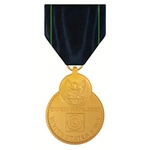
Magload- Posts : 1173
Join date : 2016-11-18
Age : 77
Location : NE Florida
 Re: Can we talk Wobble?
Re: Can we talk Wobble?
Jack,Jack H wrote:Jon,
What I interpret you are saying then is that the final two moves of the shot are simultaneously :
1. lowering at the shoulder towards your best sight picture which is already 99% established by "hold"
2. trigger finger
That's another way to look at it. When I'm lowering the pistol I'm alteady committed to shooting my shot because I'm already squeezing the trigger at least 50% by the time I get to the target. I still have time to abort though! For the most part my wobble is the same as I lower into the black and when I settle in the black. Somewhere in there the shot will/should break. The easiest 10's I shoot are the ones that break fast/soonest.
Jon
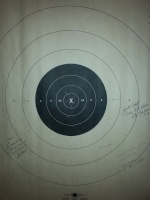
Jon Eulette- Posts : 4399
Join date : 2013-04-15
Location : Southern Kalifornia
 Re: Can we talk Wobble?
Re: Can we talk Wobble?
"The easiest 10's I shoot are the ones that break fast/soonest. "
That would be just like when T&R strings are going well.
That would be just like when T&R strings are going well.
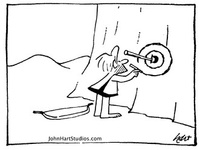
Jack H- Posts : 2699
Join date : 2011-06-10
Age : 75
Location : Oregon
 Re: Can we talk Wobble?
Re: Can we talk Wobble?
I understand that getting someone to move to the trigger prior to achieving perfect sight alignment / sight picture is challenging. I have been trying to figure out better ways to get folks to understand the concept for years.
TIMING To dispel the myth or misunderstanding, MASTER and HM shooters are not starting to move the trigger as it falls into the black and hopefully time the shot to coincide with the dot passing into the center of the black. Not happening.
WOBBLE EVERYBODY HAS WOBBLE. I HAVE WOBBLE. I also have impeccable trigger control that assists in controlling the wobble of the gun through the pressure being applied to the trigger.
If you hold the gun out in front of you it wobbles, correct? We all have a certain degree of wobble, varied by age, habits, genetics level of fitness and other things. AS we apply pressure to the trigger we will notice that the wobble will decrease, simply because we are now offering pressure of force to part of the gun, the trigger. IF you have a rolling trigger not only are you putting pressure or force to the gun you are also moving something now with that force being applied....the wobble will become even less.
DO NOT try to "time" the trigger break with sights falling into the black. Put pressure on the trigger as part of your grip, start moving the trigger before the sights are even in the black. The sights should settle into your "aiming area", again still moving (roll trigger) or building pressure (crisp trigger) on the trigger for a split second and shot should break.
From the time the gun leaves the bench and you present to the target and the shot breaks it should only take about 8 seconds, 10 seconds on the high end. DO NOT COUNT and pull the trigger. Only through a lot of dry fire will that become consistent. Have a partner time you and see if you are being consistent in your approach.
The beauty of that is if you are consistent in the presentation time frame all you need to do is figure out where in the sustained fire commands do you need start the process for the first shot. Because the first shot of every sustained fire string SHOULD be the same process as every slow fire shot that you make.
3 Guns
3 stages of fire
ONE GRIP
ONE SHOT PROCESS
TIMING To dispel the myth or misunderstanding, MASTER and HM shooters are not starting to move the trigger as it falls into the black and hopefully time the shot to coincide with the dot passing into the center of the black. Not happening.
WOBBLE EVERYBODY HAS WOBBLE. I HAVE WOBBLE. I also have impeccable trigger control that assists in controlling the wobble of the gun through the pressure being applied to the trigger.
If you hold the gun out in front of you it wobbles, correct? We all have a certain degree of wobble, varied by age, habits, genetics level of fitness and other things. AS we apply pressure to the trigger we will notice that the wobble will decrease, simply because we are now offering pressure of force to part of the gun, the trigger. IF you have a rolling trigger not only are you putting pressure or force to the gun you are also moving something now with that force being applied....the wobble will become even less.
DO NOT try to "time" the trigger break with sights falling into the black. Put pressure on the trigger as part of your grip, start moving the trigger before the sights are even in the black. The sights should settle into your "aiming area", again still moving (roll trigger) or building pressure (crisp trigger) on the trigger for a split second and shot should break.
From the time the gun leaves the bench and you present to the target and the shot breaks it should only take about 8 seconds, 10 seconds on the high end. DO NOT COUNT and pull the trigger. Only through a lot of dry fire will that become consistent. Have a partner time you and see if you are being consistent in your approach.
The beauty of that is if you are consistent in the presentation time frame all you need to do is figure out where in the sustained fire commands do you need start the process for the first shot. Because the first shot of every sustained fire string SHOULD be the same process as every slow fire shot that you make.
3 Guns
3 stages of fire
ONE GRIP
ONE SHOT PROCESS
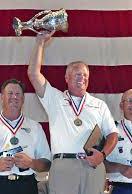
12XNPC- Posts : 25
Join date : 2017-04-16
 Re: Can we talk Wobble?
Re: Can we talk Wobble?
One other point that I just remembered as well: you're not only trying to make the arc of movement smaller, you want to make it slower as well. Consistently squeezing the trigger through a small, slow arc of movement (wobble) is the key.
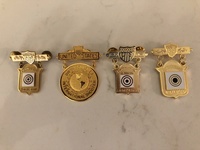
john bickar- Posts : 2280
Join date : 2011-07-09
Age : 100
Location : Menlo Park, CA
 Re: Can we talk Wobble?
Re: Can we talk Wobble?
And there is a fine line between making it smaller and forcing it smaller, which you don't want

Jack H- Posts : 2699
Join date : 2011-06-10
Age : 75
Location : Oregon
 Re: Can we talk Wobble?
Re: Can we talk Wobble?
Any training suggestions for making your arc of movement slower? Just came back from a 2700 match and many times during sustained fire while recovering from recoil, the dot is oscillating left and right so fast the dot becomes a blur (with .45, hardly happens with .22). I assume this is due to nervousness, but I could be wrong. Thanks.
Last edited by joy2shoot on 4/22/2017, 5:50 pm; edited 1 time in total (Reason for editing : added caliber comment)
joy2shoot- Posts : 570
Join date : 2014-08-02
Location : North Carolina
 Re: Can we talk Wobble?
Re: Can we talk Wobble?
john bickar wrote:One other point that I just remembered as well: you're not only trying to make the arc of movement smaller, you want to make it slower as well. Consistently squeezing the trigger through a small, slow arc of movement (wobble) is the key.
Absolutely......trigger movement will slow down that wobble to make it easier to pull the trigger.

12XNPC- Posts : 25
Join date : 2017-04-16
 Re: Can we talk Wobble?
Re: Can we talk Wobble?
Brian, I don't think that the problem is the effectiveness of the teaching. It took me a year to understand, through the experience of feeling it and doing it, some if the things that you taught.
1. Steady, even Trigger pressure reduces the wobble area.
2. A good roll trigger shows less sight movement (or none) than a crisp trigger in blank wall dryfire and on a target. Though I still seem to shoot a crisp trigger better in slow fire.
3. Slab grips are a benefit, not a liability.
1. Steady, even Trigger pressure reduces the wobble area.
2. A good roll trigger shows less sight movement (or none) than a crisp trigger in blank wall dryfire and on a target. Though I still seem to shoot a crisp trigger better in slow fire.
3. Slab grips are a benefit, not a liability.

jmdavis- Posts : 1409
Join date : 2012-03-23
Location : Virginia
 Re: Can we talk Wobble?
Re: Can we talk Wobble?
12XNPC wrote:I understand that getting someone to move to the trigger prior to achieving perfect sight alignment / sight picture is challenging. I have been trying to figure out better ways to get folks to understand the concept for years.
TIMING To dispel the myth or misunderstanding, MASTER and HM shooters are not starting to move the trigger as it falls into the black and hopefully time the shot to coincide with the dot passing into the center of the black. Not happening.
WOBBLE EVERYBODY HAS WOBBLE. I HAVE WOBBLE. I also have impeccable trigger control that assists in controlling the wobble of the gun through the pressure being applied to the trigger.
If you hold the gun out in front of you it wobbles, correct? We all have a certain degree of wobble, varied by age, habits, genetics level of fitness and other things. AS we apply pressure to the trigger we will notice that the wobble will decrease, simply because we are now offering pressure of force to part of the gun, the trigger. IF you have a rolling trigger not only are you putting pressure or force to the gun you are also moving something now with that force being applied....the wobble will become even less.
DO NOT try to "time" the trigger break with sights falling into the black. Put pressure on the trigger as part of your grip, start moving the trigger before the sights are even in the black. The sights should settle into your "aiming area", again still moving (roll trigger) or building pressure (crisp trigger) on the trigger for a split second and shot should break.
From the time the gun leaves the bench and you present to the target and the shot breaks it should only take about 8 seconds, 10 seconds on the high end. DO NOT COUNT and pull the trigger. Only through a lot of dry fire will that become consistent. Have a partner time you and see if you are being consistent in your approach.
The beauty of that is if you are consistent in the presentation time frame all you need to do is figure out where in the sustained fire commands do you need start the process for the first shot. Because the first shot of every sustained fire string SHOULD be the same process as every slow fire shot that you make.
3 Guns
3 stages of fire
ONE GRIP
ONE SHOT PROCESS
I spent a few hours over the past week or so, trying to understand this discussion, or more specifically, trying to see how I could apply it to my shooting. The following are a few random thoughts based on my experience, and one nice surprise at the end.
Since my experience at a match, I've been trying to fix the things I considered my worst issues. One was that my "wobble" was worse than I ever remember, and I don't think that my using only one hand was the problem. I tried my three grips for my Model 41 - the Hogue grips didn't allow me to grip the gun as Brian suggested in one of his videos. I put on the "custom grip" with my hand being able to wrap around the grip, but then I couldn't put my finger on the trigger as Brian suggested, so all of that came off, and the stock grips went back on. Much better. Now my fingers are where they belong, and while there was still a lot of wobble, it was better. Trigger control greatly improved, too.
I had my Aimpoint H-2 sight mounted almost as far back as I could get it on the Clark Model 41 barrel. I remember long ago, that on my High Standard, if I moved the sight forward, it improved my shooting. So I tried that and went back to dry-firing. The "wobble" is still there, but it is now about half as much as it had been. Test after test confirmed this. With everything done as per Brian's suggestions and his video, the gun now goes 'click' without the red dot moving, and the "wobble" looks more like what I think some of you are describing. It's a giant step forward, at least for me.
Consider this - if you added a large weight to the gun close to your hand, it would make the gun more difficult to hold still, because of all the weight you're holding up, but it would have no direct effect on the wobble. On the other hand, if you magically added this large weight all around the end of the barrel, the heavier the weight, the less the wobble - and with enough weight, the end of the gun wouldn't move at all, due to inertial.
I think the further away from the shooter's eye, and the closer to the end of the barrel you mount a red dot sight, the less wobble you will see when looking through the sight - as explained in this YouTube video. F = M x A, meaning for the same forces, if you increase the Mass, you decrease the Acceleration.
If I was a better shooter, maybe I wouldn't need to do this. But I'm not, and I think I do. That's twice now that doing this has helped me, first on my High Standard, and now on my Model 41.
I'm still working on the first thing Brian wrote, up above, and it's easy to read, but for me, very difficult to get myself to do. That's another discussion, but I guess in the meantime I can continue to practice applying pressure to the trigger before I'm ready to shoot.

mikemyers- Posts : 4236
Join date : 2016-07-26
Age : 80
Location : South Florida, and India
 Re: Can we talk Wobble?
Re: Can we talk Wobble?
As the pressure builds on the trigger it will help in diminishing the appearance of the wobble.
Kinda like balancing a bike on 2 wheels at dead stop without touching the ground.
How do we do that?
By applying pressure to the handlebars side to side but also by applying pressure to the pedals forward and backwards. That pressure helps to stabilize the bike.
Hence why I say the trigger is used to help stabilize the sights. Not steer the sights but stabilize the sights.
Kinda like balancing a bike on 2 wheels at dead stop without touching the ground.
How do we do that?
By applying pressure to the handlebars side to side but also by applying pressure to the pedals forward and backwards. That pressure helps to stabilize the bike.
Hence why I say the trigger is used to help stabilize the sights. Not steer the sights but stabilize the sights.

12XNPC- Posts : 25
Join date : 2017-04-16
 Re: Can we talk Wobble?
Re: Can we talk Wobble?
Brian, thanks; sometimes I am slow. I didn't realize that the reason why you start applying pressure is just to stabilize the gun. In that case, it now seems "obvious", and yes, I've noticed that applying the pressure to the trigger early helps keep the gun more steady, therefore less wobble. I went back and forth, dry firing, with and without applying pressure to the trigger, and what you wrote made a very noticeable difference.
(I was wondering last week why you said that. My rather confused brain thought it had something to do with saving time, but that didn't make sense. With what you just wrote here, it is now perfectly clear, and easy to prove to myself that it works.)
Suggestion: ".....getting someone to move to the trigger prior to achieving perfect sight alignment / sight picture...." will stabilize the gun, reduce the wobble, and allow them to sight the gun better.
(I was wondering last week why you said that. My rather confused brain thought it had something to do with saving time, but that didn't make sense. With what you just wrote here, it is now perfectly clear, and easy to prove to myself that it works.)
Suggestion: ".....getting someone to move to the trigger prior to achieving perfect sight alignment / sight picture...." will stabilize the gun, reduce the wobble, and allow them to sight the gun better.

mikemyers- Posts : 4236
Join date : 2016-07-26
Age : 80
Location : South Florida, and India
 Re: Can we talk Wobble?
Re: Can we talk Wobble?
Pre-loading the trigger does not ONLY stabilize the sights, it should be considered part of your shot process and trigger pull. If you only apply weight to the trigger when you want the shot to break it will lead to slapping/jerking the trigger
zanemoseley- Posts : 2688
Join date : 2015-07-11
Location : Cookeville, TN
 Re: Can we talk Wobble?
Re: Can we talk Wobble?
Follow-up on my previous post. This is a photo of my Model 41 after moving the Aimpoint sight forward. Result was the fun "felt" slightly heavier, but the wobble zone was greatly reduced.
Maybe there's some other reason why this is not a good idea, but for the issues that were brought up in this thread, it has now worked, twice, for me. If I was a better shot, maybe the wobble zone reduction wouldn't be a big deal, but I'm not, and for me, it is.
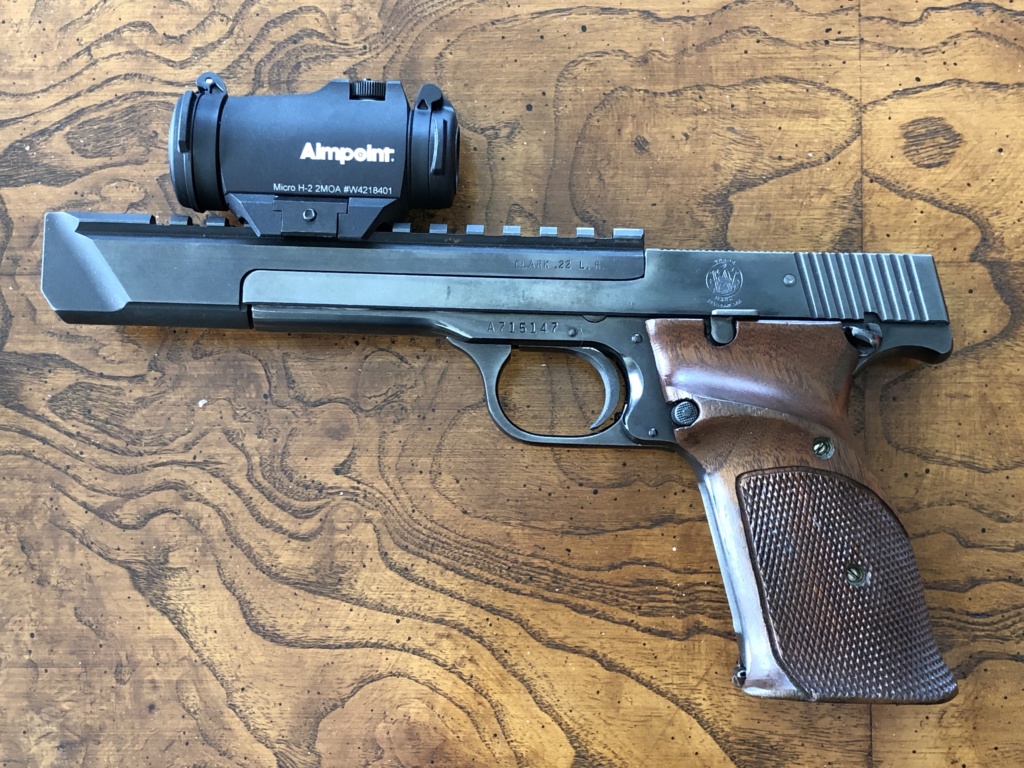
Maybe there's some other reason why this is not a good idea, but for the issues that were brought up in this thread, it has now worked, twice, for me. If I was a better shot, maybe the wobble zone reduction wouldn't be a big deal, but I'm not, and for me, it is.


mikemyers- Posts : 4236
Join date : 2016-07-26
Age : 80
Location : South Florida, and India
 Re: Can we talk Wobble?
Re: Can we talk Wobble?
There is an argument for and against this. What it boils down to is the individual and were the strength is in their hand. Some will see less wobble, some will see an increase in wobble.

12XNPC- Posts : 25
Join date : 2017-04-16
 Re: Can we talk Wobble?
Re: Can we talk Wobble?
Just a small clarification, Brian's description of the "track stand" is correct if it is a fixed gear bike. On a bike with a free-wheeling cog, you need to use the brake too.
The reason I point this out is to reinforce the original point of isometric balancing on a bike giving the same results (stabilizing muscle groups).
Here track stand is carried to an extreme
The reason I point this out is to reinforce the original point of isometric balancing on a bike giving the same results (stabilizing muscle groups).
Here track stand is carried to an extreme
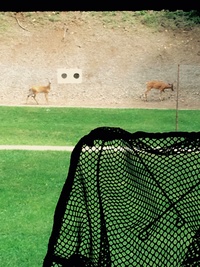
Aprilian- Posts : 987
Join date : 2016-05-13
Location : Minnesota
 Re: Can we talk Wobble?
Re: Can we talk Wobble?
You are correct sir, I really didn't think anyone would ever actually go out and do it on their bicycle to test my explanation, but yes.

12XNPC- Posts : 25
Join date : 2017-04-16
 Re: Can we talk Wobble?
Re: Can we talk Wobble?
Mike I was going suggest a barrel weight, but after seeing your picture it looks like a 7" barrel anyway. I have factory weights for my Victor that accomplishes the same issue and if using them, I sometimes don't follow through as consistently.
chopper- Posts : 820
Join date : 2013-10-29
Age : 72
Location : Western Iowa
 Re: Can we talk Wobble?
Re: Can we talk Wobble?
Less time analyzing. More time shooting. Forget the physics--it's a pretty thought, but it's simply not true in the real world. The right grips to use are the ones that let you consistently and naturally make a proper grip. Playing with weight balance and such isn't even worth thinking about at this stage of the game. Focus on shooting.
You'll reduce wobble three ways: shooting more matches to acclimate to stress, physical fitness, and practice. Wobble is not keeping you from shooting 98-100s in sustained and 90+ in slow, however. I couldn't care less about it, it's not worth my limited time. I don't need to hold to the 10 ring in order to SF 10s regularly.
Learn to call shots. I think it's a critical step in learning--not so much the ability itself, but what it means. It means the shot went precisely where it was sighted to: i.e., you didn't AIM a 10 and shoot a 6 because your trigger pull sucks. Dry fire will not teach you this because, starting out, you have no idea what a good trigger pull actually looks/feels like. Again, I think dry fire is the most over-prescribed regimen suggested to new shooters (of all disciplines). Trigger time and spotting shots is what helps.
If you can't make the shot go where you aimed it, then there is no point worrying about aiming any smaller. If you can't tell if the shot went where you aimed it, then there is no point worrying about aiming any smaller.
Analyzing 5-shot groups here and there might tell you stuff ("Hey, I threw those two 8s when I tried to make the trigger go off on 2nd and 4th shot, the other three were great" or "My grip sucks, sometimes I group to the left, sometimes to the right, sometimes way up high"). Analyzing a 50-shot shotgun-pattern doesn't tell you anything.
Did the shot go where it was called?
If not, then it's either because my trigger pull was garbage, or there's something wrong with my gun. Typically, it's because the shooter is too slow on the trigger and is interrupting the pull.
If it did, then super, that's probably half the game.
Was it a 10, or at least an almost-10 in Indoor?
If not, then you need to figure out why you pulled the shot. 9 times out of 10, I find it's a mental thing (loss of focus, making the trigger break, etc).
If yes, then super, go shoot 290s.
I don't shoot 290s, because I screw up these simple things (and also don't practice/train enough/ever). It'd be really nice to have some kind of an excuse like wobble or whatever, but that would be a lie--it's all just simple fails.
You'll reduce wobble three ways: shooting more matches to acclimate to stress, physical fitness, and practice. Wobble is not keeping you from shooting 98-100s in sustained and 90+ in slow, however. I couldn't care less about it, it's not worth my limited time. I don't need to hold to the 10 ring in order to SF 10s regularly.
Learn to call shots. I think it's a critical step in learning--not so much the ability itself, but what it means. It means the shot went precisely where it was sighted to: i.e., you didn't AIM a 10 and shoot a 6 because your trigger pull sucks. Dry fire will not teach you this because, starting out, you have no idea what a good trigger pull actually looks/feels like. Again, I think dry fire is the most over-prescribed regimen suggested to new shooters (of all disciplines). Trigger time and spotting shots is what helps.
If you can't make the shot go where you aimed it, then there is no point worrying about aiming any smaller. If you can't tell if the shot went where you aimed it, then there is no point worrying about aiming any smaller.
Analyzing 5-shot groups here and there might tell you stuff ("Hey, I threw those two 8s when I tried to make the trigger go off on 2nd and 4th shot, the other three were great" or "My grip sucks, sometimes I group to the left, sometimes to the right, sometimes way up high"). Analyzing a 50-shot shotgun-pattern doesn't tell you anything.
Did the shot go where it was called?
If not, then it's either because my trigger pull was garbage, or there's something wrong with my gun. Typically, it's because the shooter is too slow on the trigger and is interrupting the pull.
If it did, then super, that's probably half the game.
Was it a 10, or at least an almost-10 in Indoor?
If not, then you need to figure out why you pulled the shot. 9 times out of 10, I find it's a mental thing (loss of focus, making the trigger break, etc).
If yes, then super, go shoot 290s.
I don't shoot 290s, because I screw up these simple things (and also don't practice/train enough/ever). It'd be really nice to have some kind of an excuse like wobble or whatever, but that would be a lie--it's all just simple fails.
Keyholed- Posts : 110
Join date : 2015-08-05
 Re: Can we talk Wobble?
Re: Can we talk Wobble?
"Dry fire will not teach you this because, starting out, you have no idea what a good trigger pull actually looks/feels like."
I don't disagree with anything you wrote, and the sentence I quoted certainly applies to me. I get what I can from the forum and videos, especially those from Brian and Doug Koenig. Some of them help tremendously, but I haven't found anything, anywhere, that tells me enough to get a good trigger pull, only a "better" trigger pull.
The people at the range are no help - they just tell me how great I'm doing, while I was thinking how poorly I shot. They tell me a "736" was excellent, while I just see so many things I didn't do well in my own opinion.
I go to the range two to three times a week, for a few hours, and dry-fire just about every day three of four sessions a day. I'm still at the stage where I'm trying to figure out how to do things properly - to do better, all I need to do is take my left hand out of my pocket, but I'm determined to do everything with one hand.
What nobody seems to realize, is that when someone who isn't all that strong, and isn't all that young, decides to shoot one handed, the single biggest struggle is just to get strong enough to hold the gun reasonably still. Find someone who just shoots with two hands, ask them to shoot with one, and chances are, the gun will be waving all over the place, until it hurts and they lower their arm.
In time, I'm sure things will get better. In the meantime, I'll just continue doing the best I can, and as long as over time, things improve, I can't complain.
And the way I see it, I agree with you - until I can use the trigger without disturbing the aim, I'll never get "there". That's what I'm working at the hardest. .....and this thread was a goldmine of good, useful, information.
I don't disagree with anything you wrote, and the sentence I quoted certainly applies to me. I get what I can from the forum and videos, especially those from Brian and Doug Koenig. Some of them help tremendously, but I haven't found anything, anywhere, that tells me enough to get a good trigger pull, only a "better" trigger pull.
The people at the range are no help - they just tell me how great I'm doing, while I was thinking how poorly I shot. They tell me a "736" was excellent, while I just see so many things I didn't do well in my own opinion.
I go to the range two to three times a week, for a few hours, and dry-fire just about every day three of four sessions a day. I'm still at the stage where I'm trying to figure out how to do things properly - to do better, all I need to do is take my left hand out of my pocket, but I'm determined to do everything with one hand.
What nobody seems to realize, is that when someone who isn't all that strong, and isn't all that young, decides to shoot one handed, the single biggest struggle is just to get strong enough to hold the gun reasonably still. Find someone who just shoots with two hands, ask them to shoot with one, and chances are, the gun will be waving all over the place, until it hurts and they lower their arm.
In time, I'm sure things will get better. In the meantime, I'll just continue doing the best I can, and as long as over time, things improve, I can't complain.
And the way I see it, I agree with you - until I can use the trigger without disturbing the aim, I'll never get "there". That's what I'm working at the hardest. .....and this thread was a goldmine of good, useful, information.

mikemyers- Posts : 4236
Join date : 2016-07-26
Age : 80
Location : South Florida, and India
 Re: Can we talk Wobble?
Re: Can we talk Wobble?
Keyholed wrote:: i.e., you didn't AIM a 10 and shoot a 6 because your trigger pull sucks.
I'm going to totally disagree with this. A flinch/yank/jerk can easily turn a sighted 10 into a 6 or far worse. Have you scored a new shooter that has complete misses? I guarantee you their aim isn't that bad, it's just that their trigger control/execution didn't allow them to realize their aiming potential. If you watch some of Brian's videos on YouTube he essentially makes this point when discussing trigger pull.
zanemoseley- Posts : 2688
Join date : 2015-07-11
Location : Cookeville, TN
 Re: Can we talk Wobble?
Re: Can we talk Wobble?
You absolutely do aim a 10 and shoot a 6 because your trigger pull sucks. That I the whole crux of trigger control. to aim a 10 and shoot a 10 because you didn't screw it up when you pulled the trigger.
To quote Robbie Leatham "stop aiming, if you can't pull the trigger without screwing up the sights what is the point in aiming in the first place?"
To quote Robbie Leatham "stop aiming, if you can't pull the trigger without screwing up the sights what is the point in aiming in the first place?"

12XNPC- Posts : 25
Join date : 2017-04-16
 Re: Can we talk Wobble?
Re: Can we talk Wobble?
Using the stock Model 41 grips, and holding the gun as close as I can to how Brian explained it, positioning my trigger finger as he explained, and squeezing back with the middle finger and the one below it against my palm, and gradually applying pressure to the trigger, (with a one pound weight wrapped around my right wrist, for half of my dry-firing session), once I tried to "lock" my right wrist, I found that most of the time when the gun went 'click' the dot moved. Over time, eventually, it was only half the time. I took the wrist weight off, and the gun instantly felt lighter and easier to hold/control. By the time I finished the dry-firing session, the dot rarely moved when the gun went 'click'. So, I need to repeat this over and over until I can do it in my sleep without having to think about it. I am trying to document what I did, and revise my (very long) shot process.

mikemyers- Posts : 4236
Join date : 2016-07-26
Age : 80
Location : South Florida, and India
 Re: Can we talk Wobble?
Re: Can we talk Wobble?
Hello mikemyers,
Personally, I think you would benefit from a lighter pistol. One balanced to your liking but lighter, nonetheless.
Jim
Personally, I think you would benefit from a lighter pistol. One balanced to your liking but lighter, nonetheless.
Jim
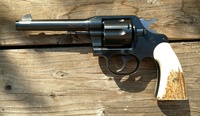
spursnguns- Posts : 611
Join date : 2013-01-04
Age : 66
Location : Nampa, Idaho
 Re: Can we talk Wobble?
Re: Can we talk Wobble?
As shorter barreled Model 41 would be a great start. That long 7 inch barrel is a killer.

12XNPC- Posts : 25
Join date : 2017-04-16
 Re: Can we talk Wobble?
Re: Can we talk Wobble?
I would not recommend a long barreled M41 to any new shooter. Unfortunately, the 5.5" barrel length is actually heavier. I believe "mikemyers" has a much lighter High Standard....I would go that route.
Jim
Jim

spursnguns- Posts : 611
Join date : 2013-01-04
Age : 66
Location : Nampa, Idaho
Page 2 of 6 •  1, 2, 3, 4, 5, 6
1, 2, 3, 4, 5, 6 
 Similar topics
Similar topics» The Wobble
» Where does wobble come from?
» Another Wobble Question
» Wobble area
» Wobble Area Sometimes Twitchy
» Where does wobble come from?
» Another Wobble Question
» Wobble area
» Wobble Area Sometimes Twitchy
Page 2 of 6
Permissions in this forum:
You cannot reply to topics in this forum